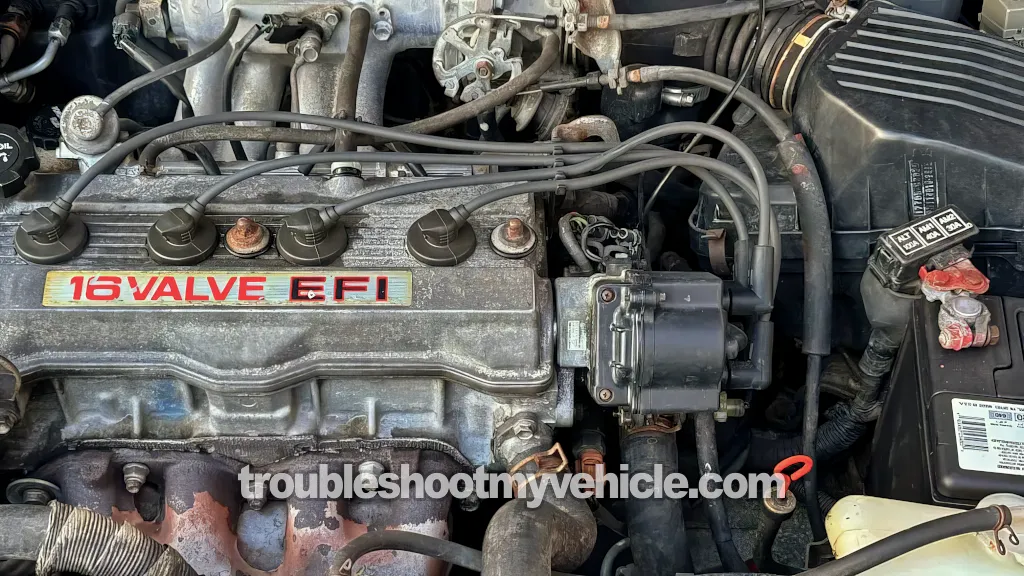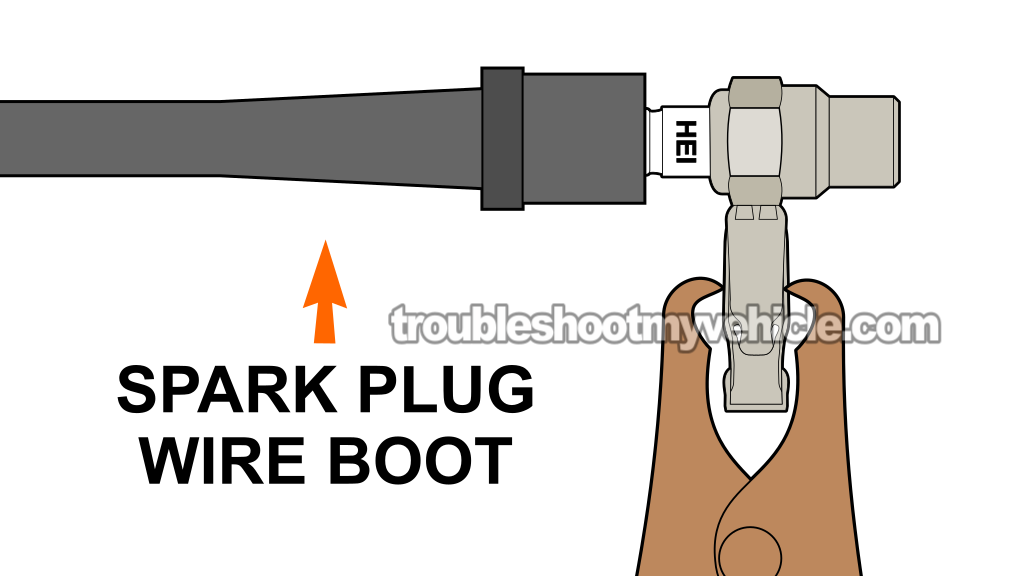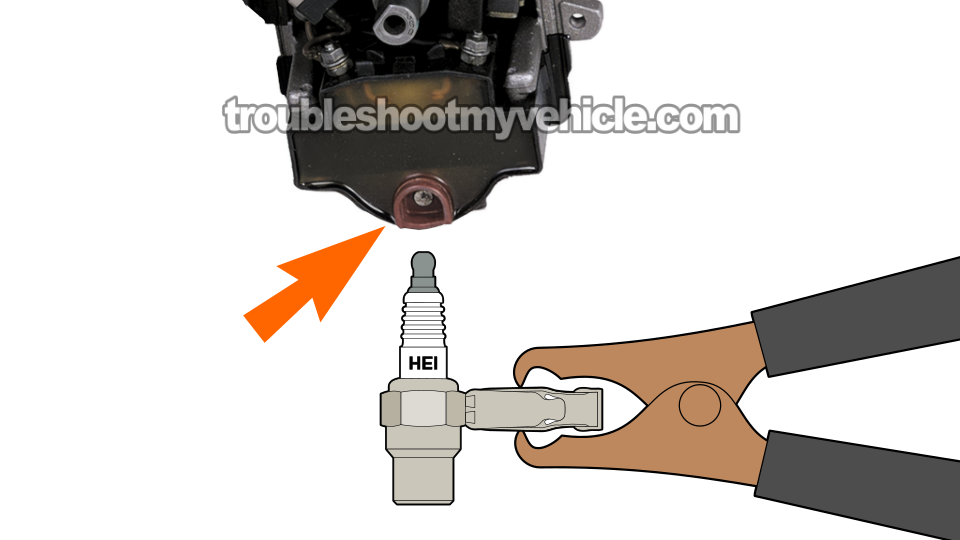
If your 1989-1992 Toyota Corolla's 1.6L (4A-FE) engine won't start, you might have a bad ignition coil that's not sending spark to the spark plugs and causing the problem.
The good news? You can figure this out fast with my simple, step-by-step diagnostic method, and in this tutorial, I'm gonna show you how.
NOTE: The ignition coil test is performed with everything still installed in the engine. The distributor is only shown removed in the images for a clearer view of the connections. No need to take it out for any of the tests.
Contents of this tutorial:
- Ignition Coil Basics.
- What Tools Do I Need To Test The Ignition System?
- Where To Buy The Ignition Coil And Save.
- TEST 1: Checking The Spark Plug Wires For Spark.
- TEST 2: Checking The Ignition Coil For Spark.
- TEST 3: Checking The Distributor Cap For Spark.
- TEST 4: Making Sure The Ignition Coil Is Getting Power.
- TEST 5: Making Sure The Ignition Coil Is Getting Its Activation Signal.
- More 1.6L Toyota Corolla Tutorials.
APPLIES TO: This tutorial applies to the following vehicles:
- 1.6L (4A-FE) Toyota Corolla: 1989, 1990, 1991, 1992.
- 1.6L Geo Prizm: 1990, 1991, 1992.
Ignition System Wiring Diagrams:
- Ignition System Wiring Diagram (1989 1.6L Toyota Corolla).
- Ignition System Wiring Diagram (1990-1992 1.6L Toyota Corolla).
Ignition System Diagnostic Tests:
- How To Test The Igniter (1989-1992 1.6L Toyota Corolla).
- How To Test The Distributor Pickup Coil (1989-1992 1.6L Toyota Corolla).
Engine No-Start Diagnostics:
Ignition Coil Test Tutorials:
- How To Test The Ignition Coil (1993-1995 1.6L Toyota Corolla).
- How To Test The Ignition Coil (1996-1997 1.6L Toyota Corolla).
Ignition Coil Basics
The ignition coil is a critical component of your vehicle's ignition system. It's core function is to transform the 12 Volts into the high-voltage spark necessary to ignite the air-fuel mixture in the engine's cylinders.
Here's a breakdown of how it works:
- Pickup coil signals: When you turn the key and crank the engine, the pickup coil inside the distributor generates and sends two signals —RPM (NE) and crankshaft position (G)— to the fuel injection computer.
- Igniter (ignition control module) activation: When the fuel injection computer receives these signals (NE and G), it sends an activation signal to the igniter.
- Ignition coil activation: The igniter, after receiving its activation signal, activates the ignition coil, which is located inside the distributor.
- Ignition coil spark: The ignition coil then transforms the 12V battery power into high voltage.
- Spark distribution: This high voltage is sent from the coil to the spark plugs through the distributor cap and rotor.
- Cylinder ignition: The distributor directs the high voltage to the correct cylinder's spark plug. As the voltage reaches the spark plug, it jumps across the spark plug gap, creating a spark that ignites the air-fuel mixture.
- Engine starts: When this process happens in all four cylinders, the engine starts and runs.
The most important thing to keep in mind (to effectively diagnose the ignition coil) is that it relies on receiving both an activation signal from the igniter and battery power to function correctly.
If either of these is missing, the coil isn't going to generate the spark needed to start and keep the engine running.
What Tools Do I Need To Test The Ignition System?
Here are the three tools you'll need to test the ignition system on your 1989-1992 1.6L Toyota Corolla:
- Spark tester: A spark tester is important for an accurate spark test result. There are many you can choose from, the one I recommend using is the OTC HEI spark tester. You can view an example of this tool and purchase it here: OTC 6589 Electronic Ignition Spark Tester (at: amazon.com).
- Multimeter: A multimeter will help verify that the ignition coil is receiving power (TEST 4). If you don't have one, I recommend this one: Tekpower TP8268 AC/DC Auto/Manual Range Digital (at: amazon.com).
- 12 Volt automotive test light: This test light will help us make sure the ignition coil is getting its activation signal in TEST 5. If you don't have one, this is the one I use and recommend: Lisle 28400 Heavy Duty 12 Volt Test Light (at: amazon.com).
Where To Buy The Ignition Coil And Save
I'm recommending the Standard Motor Products UF204 Ignition Coil as the one you should purchase, since it's a well-known after-market brand. Once you get to amazon.com thru the links below, you can also choose other brands too!
Disclosure: As an Amazon Associate, I earn from qualifying purchases. If my tutorials help you, using these links is an easy way to support the site at no extra cost to you. Thank you!
NOTE: Not sure if this ignition coil fits your Corolla? No worries! When you click the link and head to the site, they'll ask for your car's details to make sure it matches. If it doesn't, they'll help you find the right one.
TEST 1: Checking The Spark Plug Wires For Spark

To figure out why your Corolla won't start, we're gonna check for spark at each spark plug wire first. This step will help us see if the engine no-start problem is due to a lack of spark.
For the best results, make sure you use a dedicated spark tester. The one I recommend (I use it myself, and it works straight out of the box) is the OTC 6589 Electronic Ignition Spark Tester. You can check it out and grab one here: OTC 6589 Electronic Ignition Spark Tester (at: amazon.com).
Let's jump in:
- 1
Pull the spark plug wire off of the #1 cylinder spark plug.
- 2
Insert the spark tester into the spark plug wire.
- 3
Ground the spark tester directly on the battery's negative (-) terminal using a battery jump-start cable.
- 4
Have someone crank the engine while you watch the spark tester.
- 5
You'll get one of two results: Spark or no spark.
- 6
Remove the spark tester from the spark plug wire and connect it (the wire) back onto its spark plug.
- 7
Repeat steps 1 through 6 on the remaining spark plug wires.
Let's break down what your test result means:
CASE 1: All four spark plug wires sparked. That's exactly what you wanna see —it means the ignition system isn't causing the engine's no-start issue.
You can also rule out problems with these parts:
- The igniter (ignition control module).
- The ignition coil.
- The pickup coil (inside the distributor).
- The distributor cap and rotor.
- The spark plug wires.
If the engine still won't start, the problem isn't in the ignition system.
CASE 2: Some, but not all, spark plug wires sparked. This usually means the wires that didn't spark are bad, or the distributor cap has failed.
To dig deeper, head over to: TEST 3: Checking The Distributor Cap For Spark.
CASE 3: None of the spark plug wires sparked. That confirms the engine isn't starting because there's no spark at all.
Next step? Check if the ignition coil itself is sparking. Go to: TEST 2: Checking The Ignition Coil For Spark.
TEST 2: Checking The Ignition Coil For Spark

In most cars, the ignition coil sits outside the distributor, and a high-tension wire connects the coil to the distributor to send the spark.
But in the 1989–1992 1.6L Toyota Corolla, the ignition coil is inside the distributor. In this setup, the ignition coil delivers the spark directly to the distributor cap.
From there, the cap sends the spark to the distributor rotor, which then redirects it to the metal terminals inside the distributor cap.
From there, the spark travels through the distributor cap towers to the spark plug wires, finally reaching each of the four spark plugs.
In this section, we're gonna take off the distributor cap and use a spark tester to check for spark right at the ignition coil.
- If the ignition coil sparks: The problem is probably a bad distributor cap or rotor, which is stopping the engine from starting.
- If there's no spark: We'll move on to TEST 4 to keep troubleshooting the issue.
IMPORTANT: When you're testing the ignition coil for spark, watch the distributor rotor — it should turn while the engine cranks. If it doesn't turn, your timing belt is broken, and that's what's keeping the engine from starting.
Alright, let's get to it:
- 1
Take off the distributor cap from the distributor.
- 2
Place the spark tester on top of the ignition coil's metal terminal.
NOTE: The spark tester may move off of the terminal while cranking the engine, so it might be a good idea to wrap them together with black electrical tape. This ensures they stay connected and have solid metal-to-metal contact while the engine is cranking. - 3
Ground the spark tester to the battery's negative (-) terminal using a jump-start cable.
- 4
Have someone crank the engine while you keep an eye on the spark tester.
- 5
You'll see one of two results: Spark or no spark.
Let's break down what your test result means:
CASE 1: The spark tester sparked. That's exactly what we wanna see.
If you've:
- Confirmed that all four spark plugs aren't sparking (TEST 1).
- Confirmed in this test that the ignition coil is sparking.
Then the no-spark problem (at the spark plug wires) causing the engine to no-start is due to a bad distributor rotor or cap, and they need to be replaced.
CASE 2: The spark tester DID NOT spark. No spark usually means one of these things:
- The ignition coil is bad.
- The ignition coil isn't getting power.
- The ignition coil isn't getting its activation signal from the igniter.
Next, you'll need to check if the ignition coil is getting voltage. Go to: TEST 4: Making Sure The Ignition Coil Is Getting Power.


